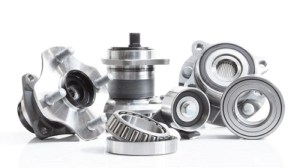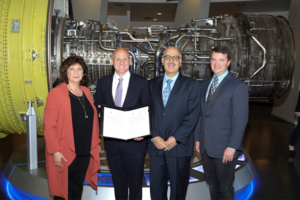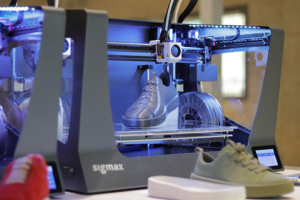In this Halloween week edition of 3D Printing News Briefs, we’re telling you about a report, an agreement, and 3D printed footwear. SmarTech Analysis has released its market analysis report on metal 3D printing. GE Additive has signed a R&D agreement with Oak Ridge National Laboratory. Finally, multinational company Camper is using BCN3D’s technology to revolutionize its footwear design process.
SmarTech Analysis Releases New Metal 3D Printing Report
 This week, industry analysis and market consulting services provider SmarTech Analysis released a new report centered on production market opportunities in metal additive manufacturing. Titled “Metal Additive Manufactured Parts Produced,” the report offers insight into what specific applications and industries are driving metal AM, which is expected to generate $228 billion worth of components over the next ten years.
This week, industry analysis and market consulting services provider SmarTech Analysis released a new report centered on production market opportunities in metal additive manufacturing. Titled “Metal Additive Manufactured Parts Produced,” the report offers insight into what specific applications and industries are driving metal AM, which is expected to generate $228 billion worth of components over the next ten years.
“Through its advanced market modeling techniques which have been adopted throughout the additive manufacturing industry to help inform and quantify market opportunities, SmarTech is now pleased to present a study and accompanying dataset as a method of understanding metal additive manufacturing output, and its value to the various industries which metal AM users are active within. This research analysis is intended to help quantify the ways in which metal AM technologies are applied today and may be applied in the future, and the impact that these technologies will have on specific markets as time goes on,” SmarTech Analysis’s Rob Nolan explained in an email.
The report lists some of the trends expected to impact metal AM’s production structure over the next decade, including efficiency and production-cost improvements of the individual technologies and continuing efforts in design for additive manufacturing (DfAM). You can request an excerpt, or purchase the entire report, on SmarTech’s website.
GE Additive and Oak Ridge National Laboratory Sign Agreement

L-R: Christine Furstoss, CTO, GE Additive; Daniel Simmons, Assistant Secretary, US Department of Energy – Office of Energy Efficiency and Renewable Energy; Moe Khaleel, Associate laboratory director for Energy and Environmental Sciences; and Chris Schuppe, general manager, engineering, GE Additive.
At the GE Additive Technology Center in Cincinnati this week, GE Additive and the US Department of Energy’s Oak Ridge National Laboratory (ORNL) signed a five-year cooperative research and development agreement (CRADA), which is centered on the software, processes, and materials needed to encourage AM adoption and drive industrialization. This CRADA, which supersedes a separate one that’s been in place since 2012, covers all GE Additive materials, equipment, and engineering services, and is focused on creating, and implementing, novel 3D printing technologies into commercial products.
Daniel R. Simmons, Assistant Secretary for DOE’s Office of Energy Efficiency and Renewable Energy, said, “By collaborating with industry partners such as GE Additive, DOE’s Oak Ridge National Laboratory brings its multi-disciplinary expertise and capabilities to bear on real-world challenges and moves technologies into the marketplace where they will have the greatest economic impact.”
Camper Uses 3D Printing to Revolutionize Footwear Design Process
 Spanish footwear manufacturer Camper is enhancing the creativity of its designers and engineers by integrating desktop Sigma and Sigmax 3D printers from Barcelona company BCN3D. Each of Camper’s shoe collections have some modicum of geometric complexity, and in order to reliably create detailed models, they are using flexible materials and BCN3D’s printers to create realistic prototypes. They are able to create lightweight, ergonomic 3D printed components on fabric, without the use of molds.
Spanish footwear manufacturer Camper is enhancing the creativity of its designers and engineers by integrating desktop Sigma and Sigmax 3D printers from Barcelona company BCN3D. Each of Camper’s shoe collections have some modicum of geometric complexity, and in order to reliably create detailed models, they are using flexible materials and BCN3D’s printers to create realistic prototypes. They are able to create lightweight, ergonomic 3D printed components on fabric, without the use of molds.
“With various 3D printers on site, Camper’s designers now have new designs literally in the palms of their hands. This is a huge advantage for designers because they can now validate volumes, dimensions and geometric shapes that they could not visualise with a digital model,” BCN3D’s CEO Xavier Martínez Faneca said. “If designers can print a shoe model in 3D the next day, the design team has the ability to take their creative potential further. With collaboration, they can really achieve the product they are looking for. Before, design processes were much slower.”
Discuss these stories and other 3D printing topics at 3DPrintBoard.com or share your thoughts in the Facebook comments below.
Subscribe to Our Email Newsletter
Stay up-to-date on all the latest news from the 3D printing industry and receive information and offers from third party vendors.
You May Also Like
Gorilla Sports GE’s First 3D Printed Titanium Cast
How do you help a gorilla with a broken arm? Sounds like the start of a bad joke a zookeeper might tell, but it’s an actual dilemma recently faced by...
Nylon 3D Printed Parts Made More Functional with Coatings & Colors
Parts 3D printed from polyamide (PA, Nylon) 12 using powder bed fusion (PBF) are a mainstay in the additive manufacturing (AM) industry. While post-finishing processes have improved the porosity of...
$25M to Back Sintavia’s Largest Expansion of Metal 3D Printing Capacity Since 2019
Sintavia, the digital manufacturing company specializing in mission-critical parts for strategic sectors, announced a $25 million investment to increase its production capacity, the largest expansion to its operations since 2019....
Velo3D Initiates Public Offering in a Bid to Strengthen Financial Foundations and Drive Future Growth
Velo3D (NYSE: VLD) has been among a number of publicly traded 3D printing firms that have attempted to weather the current macroeconomic climate. After posting a challenging financial report for 2023,...































